KOREAN SPICY NOODLES ARE EASY TO MAKE AT HOME AND BETTER THAN YOUR FAVORITE RESTAURANT!
Korean Noodles are a glass noodle stir fry loaded with tender beef, mushrooms, carrots, onions and bell peppers all bathed in a spicy soy, ginger, garlic sesame sauce. It is a symphony of tantalizing flavors and textures and one of my favorite recipes to date – you don’t want to miss this one! Most of the work for these Korean Spicy Noodles is slicing your steak/veggies beforehand, so when its “go” time you can have dinner on the table in less than 15 minutes!
What Are Korean Spicy Noodles?
Spicy Korean Noodles are a type of Korean stir-fried noodles (chap chae or jap chae, Japchae translates as mixed vegetables) and is one of the most popular noodle dishes in Korea, and for good reason. These Korean Noodles have to be one of my favorite noodle dishes of all time!
Korean Spicy Noodles are characterized by the spicy savory sauce, the use of glass noodles (more on noodles below), thinly sliced protein (usually steak) and vegetables, usually thinly sliced onions, carrots, mushroom, spinach and sometimes bell peppers.
I love this cast of characters together but, you can customize your Korean Noodles with whatever you have on hand. They would be delicious with chicken or shrimp, or even go vegetarian, and the veggies can completely be swapped for your favs, or whatever you have on hand.
What are Korean noodles made out of?
The foundation of Korean Spicy Noodles is the glass noodle made with sweet potato starch, called dangmyeon, sometimes called Korean vermicelli, not to be confused with rice vermicelli used in Sesame Noodles.. Glass Noodles are gluten free, fat free, light, springy and absorbs a ton of flavor while still remaining al dente
Glass noodles gets their name from the fact that the gray, opaque noodles transform into translucent, spiral glass-like noodles when cooked.
The delightfully chewy texture of glass noodles reminds me of the rice noodles used in Pad Thai, and similarly, they remain perfectly al dente texture if not overcooked initially, which makes them great for leftovers.

Where Can I Buy Korean Noodles?
You can buy Korean Noodles on Amazon or in any Asian specialty store but take care you are purchasing the correct glass noodles.
I purchased my Korean Noodles on Amazon and they were called, “Glass Noodles, Korean Vermicelli, Dangmyun, Sweet Potato Starch” so there was no question whether or not I was purchasing the correct Korean glass noodles.

Glass noodles come in a few different varieties. Non-Korean glass noodles are often made with mung bean starch or green pea starch. They can also have different shapes from thin noodles to wide, flat noodles resembling brownish, clear fettucine. We are looking for the thicker, round, grey Korean noodles made from sweet potato starch. If you aren’t sure if the noodles are correct, check the ingredient list for sweet potato starch.
I’m sure these Korean Spicy Noodles would taste great with any noodle, but if you are going to the trouble of buying noodles, it would be nice purchase the correct authentic ones.

How do I Cook Korean Glass Noodles?
Glass noodles are boiled like traditional pasta but for a shorter amount of time, usually about 5 minutes, or even less if you are cooking a small quantity of noodles.
Take care to rinse and drain the glass noodles in cold water a few times to rinse out the excess starch. If you aren’t immediately adding your Korean Noodles to a sauce, then toss them with a teaspoon of oil to keep them from sticking together.
Korean Noodles come in very long strands, so you will want to cut them with kitchen shears before stir-frying.
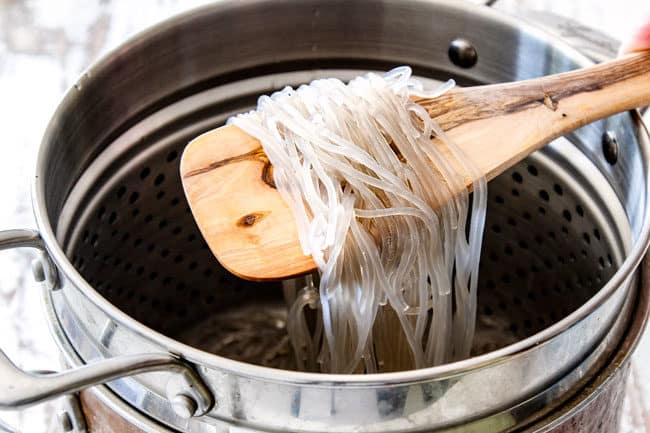
WHAT KIND OF MEAT IS USED FOR Spicy Korean Noodles?
Rib eye is often use in Korean Spicy Noodles, but I like to use the more economical flanks steak. Although less expensive, flank steak transforms into melt-in-your-mouth-tender by slicing it thin, marinating it and not overcooking it. You will be astonished just how buttery delicious flank steak can become!
HOW DO YOU TENDERIZE BEEF?
The beef in our Korean Spicy Noodles is one of the stars. It is dripping with flavor and buttery tender due to our marinade which also doubles as our sauce.
You can either marinate your beef at room temperature for 30 minutes or up to 8 hours in the refrigerator. This is how our marinade ingredients tenderize our beef:
- soy sauce: the salt in the soy sauce helps break down the proteins for a more tender texture.
- Japanese rice wine: is an acidic ingredient that breaks down lean muscle fibers on the surface meat.
- cornstarch: acts as a binder and helps our soy sauce and rice wine come together and bind to the meat. It also provides a light coating that helps protects it from the intense heat when cooking.

WHAT IS KOREAN SPICY NOODLES SAUCE?
The sauce for Korean Spicy Noodles is one of my absolute favorites. I adapted it slightly from my Korean Beef Bowls, because of its irresistible savory, salty, spiciness. It is a soy-based marinade/sauce which includes:
- Toasted sesame oil
- Low sodium soy sauce
- Brown sugar
- Japanese rice wine
- Gochujang
- Ginger
- Garlic
- Pepper
- Cornstarch
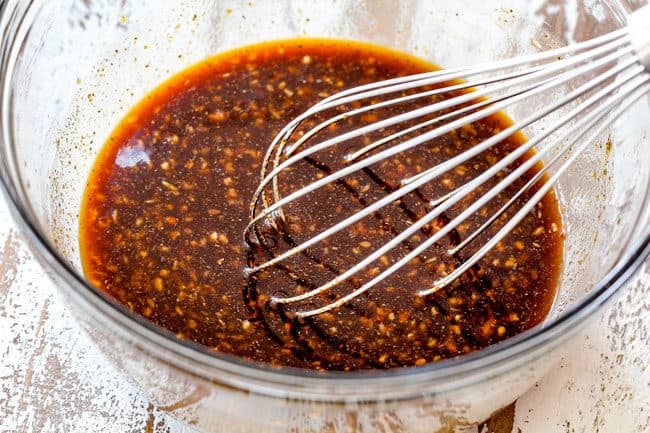
The cornstarch tenderizes the beef and also helps thicken the sauce. I also like to add 1 ½ teaspoon beef bouillon to the sauce, but this is optional. When I tasted the Korean Sauce without the bouillon, I thought it was missing something, and when I added the bouillon, it was perfect. If you don’t keep beef bouillon on hand you can omit it and season your Korean Spicy Noodles with salt to taste at the very end of cooking.
You might be wondering about the Gochujang and the rice wine. Rice wine should become a pantry staple if you do much Asian cooking. Rice wine is NOT rice vinegar- DO NOT switch them out. Rice wine adds a sweetness and depth of flavor while also tenderizing the beef. Rice vinegar, on the other hand will add an acidic flavor.
I use “Kikkoman Aji-Mirin: Sweet Cooking Rice Seasoning” which is commonly found in the Asian section of most grocery stores or you can Amazon it. I highly suggest you google image before you head off to the grocery store so you know exactly what you are looking for. The best substitute for rice wine is pale dry sherry.
WHAT IS GOCHUJANG AND WHERE CAN I BUY IT?
Gochujang brings the heat to these Korean Spicy Noodles. Gochujang is a Korean BBQ Sauce that’s the perfect blend of savory, sweet and spicy and one of my absolute favorite Asian condiments.
I use Annie Chun’s Sweet and Spicy Gochujang Sauce located in the Asian section of my grocery store, but you can also purchase it on Amazon. I do recommend looking to see what Annie Chun’s Gochujang Sauce looks like so you can easily spot it at the grocery store.

How Spicy Are korean spicy noodles?
I would say these Korean Spicy Noodles are medium spicy and would be the right amount of heat for those who like spice. If you LOVE spicy, you will want to add more than 2 tablespoons Gochujang.
If you know you don’t like spicy foods at all then use less than 2 tablespoons Gochuchang. You can even start with less Gochuchang in the marinade/sauce and add more to individual servings.
HOW DO YOU MAKE korean spicy noodles?
Our Korean Spicy Noodles recipe is very simple but the veggies require some chopping and there is some hands-off time due to the marinating. If you prep your veggies while your beef is marinating, then your noodles can come together super quickly when its “go time.”
- Slice your beef thinly. The key to tender beef in Korean Spicy Noodles is to THINLY slice your steak across the grain, 1/8-1/4.” It is much easier to thinly slice your steak if you freeze it for 1-2 hours, or until it is firm enough to hold shape but still soft enough to slice. I like to cut the beef in half and place one half in the freezer until I am finished slicing the first half so it doesn’t start to defrost on the cutting board.
- Slice your beef across the grain. You also want to take care to slice the beef ACROSS the grain. You can see the “grain” running through the meat in one direction. The grain is essentially the muscle fibers running through the meat. You want to cut perpendicular to the muscle fibers so they become as short as possible. If you cut it parallel to the grain you will end up with long muscle fibers AKA chewy, rubbery tough meat so cut AGAINST the grain!

- Marinate your beef. Whisk all the marinade ingredients together in a glass dish or freezer size bag – whatever you are going to marinate your steak in and add your steak. Marinate 30 minutes at room temperature or up to 8 hours in the refrigerator. While your beef is marinating, prep the rest of your ingredients so dinner can come together quickly.

- Cook Noodles. I suggest cooking your Korean Noodles according to package directions. They will probably require boiling for about 5 minutes. Take care to rinse them thoroughly once cooked to remove excess starch. Once they are cooked, cut them with kitchen shears otherwise the extremely long noodles can be hard to toss in the sauce.
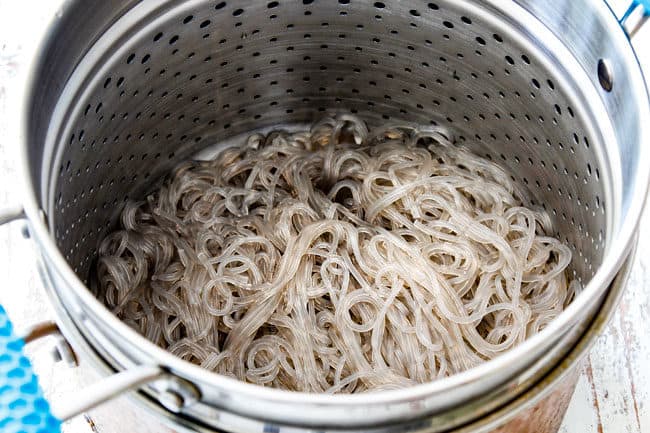
- Sear beef. Heat vegetable or peanut oil (you can substitute with any high smoking neutral oil) in a large nonstick skillet over high heat until very hot and sizzling. Your pan should be hot enough so that the meat sizzles as soon as it touches the pan. We want the outside of our meat to develop a nice sear while the inside remains tender, this ensures juicy steak. Add beef to the skillet in a single layer and sear, then flip over and sear the other side. Your beef will cook more in the sauce so don’t overcook it or it won’t be as tender! Transfer beef to a large plate and cover. You will need to cook your beef in two batches so it sears and doesn’t just steam.

- Stir fry. To the now empty pan, heat sesame oil and add the onions, mushrooms, and carrots and sauté for 3 minutes. Add the bell peppers and stir-fry until crisp tender, about 2 additional minutes. The total time may vary depending on how thinly sliced your veggies are. You want your bell peppers to remain crisp-tender and not soggy, so sample a few along the way. We use sesame oil to cook the vegetables and not the beef because it doesn’t have as high of a smoking point as vegetable oil needed for the beef.

- Combine. Add the noodles, beef and reserved sauce and cook while stirring until noodles are warmed through and sauce has thickened slightly. We are liberal with the sauce because Korean noodles easily absorb liquid which makes them a fabulous flavor sponge.

- Final Touches. Add spinach and cook and stir one minute, or just until spinach begins to wilt. Taste and add additional Gochuchang if desired for more heat. Garnish with green onions and sesame seeds.


Korean Spicy Noodles Recipe Notes
- Prep. Have all of your ingredients ready/veggies sliced before you start your stir fry.
- Mushrooms. Purchase fresh shiitake mushrooms. If you purchase dried mushrooms you will have to soak them in water before using them. You may also substitute another variety of mushroom.
- Carrots. If you don’t cut your own matchstick carrots, then store-bought matchstick carrots will be much thinner. Add store-bought matchstick carrots to the skillet with the bell peppers and NOT the onions/mushrooms.
- Customize. Feel to customize the veggie and use your favorites.
LOOKING FOR MORE KOREAN RECIPES?
- Beef Bulgogi
- 30 Minute Korean Beef Bowls
- Korean BBQ Burgers with Miso Candied Bacons
- Saucy Korean Beef Stir Fry
- Korean Steak Tacos
WANT TO TRY THIS KOREAN SPICY NOODLES RECIPE?
Pin it to your ASIAN, BEEF, or DINNER BOARD to save for later!
Find me on Pinterest for more great recipes! I am always pinning :)!
©Carlsbad Cravings by CarlsbadCravings.com

Korean Spicy Noodles
Save This Recipe To Your Recipe Box
You can now create an account on our site and save your favorite recipes all in one place!
Ingredients
Stir Fry
- 1 pound flank steak cut across the grain into thin slices then cut into 2” length pieces
- vegetable or peanut oil
- toasted sesame oil
- 8 oz. Korean sweet potato starch noodles (dangmyeon) see notes
- 1 yellow onion thinly sliced, then cut into 1” lengths
- 3.5 oz. shiitake mushrooms sliced
- 1 cup carrots, cut into matchsticks from about 3 medium carrots
- 1 red bell pepper sliced
- 2 cups baby spinach about 2 oz.
Marinade/Sauce
- 1/3 cup low sodium soy sauce
- 3 tablespoons brown sugar
- 2 tablespoons rice wine (NOT VINEGAR) may substitute dry sherry (see notes)
- 2 tablespoons Gochujang or more if desired*
- 1/2 teaspoon pepper
- 3 garlic cloves minced
- 1 tablespoon freshly ground ginger (may substitute 1 teaspoon ground)
- 1 tablespoon cornstarch
Add later:
- 1 1/2 teaspoons beef bouillon
Garnish
- 3 green onions chopped
- 1 tablespoon sesame seed
Instructions
- Whisk together marinade/sauce ingredients in a medium bowl (not beef bouillon). Add ¼ cup marinade to a freezer bag/glass dish then whisk in 1 tablespoon sesame oil. Add beef and massage in marinade. Marinate at room temperature for 30 minutes or refrigerate for 2-8 hours (longer the better). To the remaining reserved Sauce, whisk in 1 ½ teaspoons beef bouillon. Cover Sauce and refrigerate until ready to use.
- Cook the noodles according to package directions just until al dente, taking care not to overcook. Rinse noodles several times in cold water. Snip noodles with kitchen shears into manageable lengths.
- Heat 1 ½ teaspoons vegetable oil (or other neutral oil) in a large nonstick skillet over high heat until hot and sizzling. Add half of the beef to the skillet in a single layer, cook without stirring for 1 minute, then flip beef over and sear just until browned, about 1-2 minutes (it will cook more in the sauce). Don’t overcook or it won’t be as tender! Transfer beef to a large plate and cover. Repeat with remaining beef.
- Wipe out pan. To the now empty pan, heat 2 teaspoons sesame oil over medium high heat. Add the onions, mushrooms, and carrots and sauté for 3 minutes. Add the bell peppers and stir-fry until crisp tender, about 2 additional minutes.
- Add the noodles, beef and reserved sauce and cook while stirring until noodles are warmed through and sauce has thickened slightly. Add spinach and cook and stir one minute, or just until spinach begins to wilt.
- Taste and add additional gochuchang if desired for more heat. Garnish with green onions and sesame seeds.
Notes
Where Can I Buy Korean Noodles?
- You can buy Korean Noodles on Amazon or in any Asian specialty store but take care you are purchasing the correct glass noodles.
- I purchased my Korean Noodles on Amazon and they were called, “Glass Noodles, Korean Vermicelli, Dangmyun, Sweet Potato Starch.”
- Glass noodles come in a few different varieties. Non-Korean glass noodles are often made with mung bean starch or green pea starch. They can also have different shapes from thin noodles to wide, flat noodles resembling brownish, clear fettuccine. We are looking for the thicker, round grey Korean noodles made from sweet potato starch. If you aren’t sure if the noodles are correct, check the ingredient list for sweet potato starch.
TIPS AND TRICKS
- Gochuchang. Gochuchang is a Korean BBQ Sauce that’s the perfect blend of savory, sweet and spicy. I use Annie Chun’s Sweet and Spicy Gochujang Sauce located in the Asian section of my grocery store, but you can also easily buy it on Amazon.
- Rice Wine. Rice wine is NOT rice vinegar- DO NOT switch them out. I use “Kikkoman Aji-Mirin: Sweet Cooking Rice Seasoning” which is commonly found in the Asian section of most grocery stores or you can Amazon it. I highly suggest you google image before you head off to the grocery store so you know exactly what you are looking for. The best substitute for rice wine is pale dry sherry.
- Freeze beef. The easiest way to thinly slice beef is while it is partially frozen. Wrap beef in plastic wrap or place in a freezer bag and freeze 1-2 hours until it is firm enough to hold shape but still soft enough to slice. I like to cut the beef in half and place one half in the freezer until I am finished slicing the first half so it doesn’t start to defrost on the cutting board.
- Cut beef across the grain. You can see the “grain” running through the meat in one direction. The grain is essentially the muscle fibers running through the meat. You want to cut perpendicular to the muscle fibers so they become as short as possible as opposed to long muscle fibers. Long muscle fibers will give you chewy, rubbery tough meat – so cut AGAINST the grain.
- Use a hot skillet. Your pan should be hot enough so that the meat sizzles as soon as it touches the pan. We want the outside of our meat to develop a nice sear while the inside remains tender, this ensures juicy steak.
- Don’t overcrowd your pan. Cook your steak in 2 batches so you don’t overcrowd your skillet which will steam instead of sear your beef.
- Mushrooms. Purchase fresh shiitake mushrooms. If you purchase dried mushrooms you will have to soak them in water before using them. You may also substitute another variety of mushroom.
- Carrots. If you don’t cut your own matchstick carrots, then store-bought matchstick carrots will be much thinner. Add store-bought matchstick carrots to the skillet with the bell peppers and NOT the onions/mushrooms.
- Customize. Feel to customize the veggie and use your favorites.
- Heat. Start with less than 2 tablespoons Gochuchang if you know you don’t like much heat. Add more Gochuchang to taste at the end for spicier Korean Spicy Noodles.

Did You Make This Recipe?
Tag @CarlsbadCravings and Use #CarlsbadCravngs
Leave a Review, I Always Love Hearing From You!
Carlsbad Cravings Original

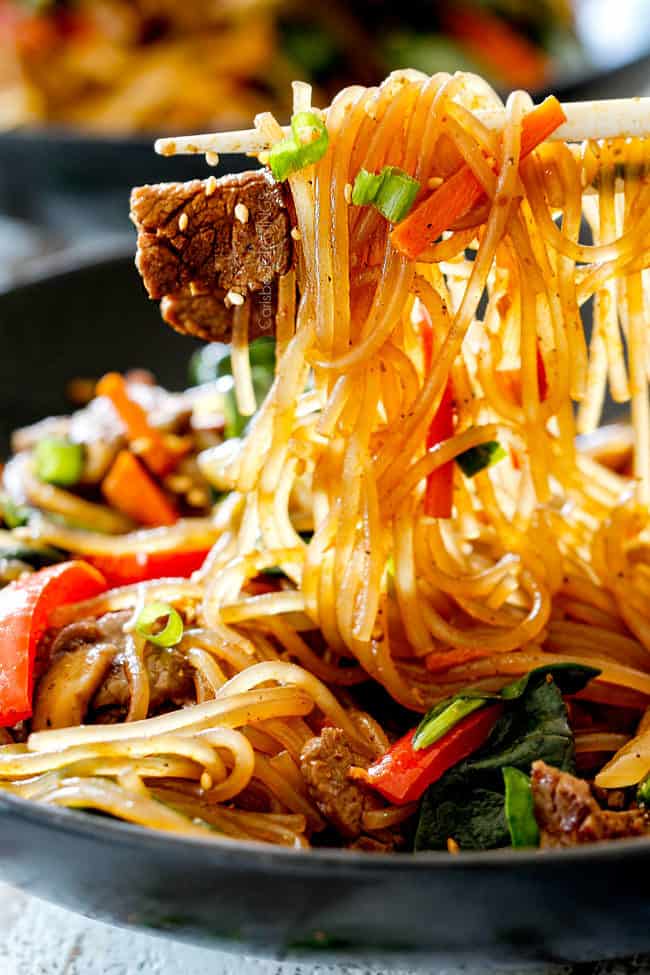
















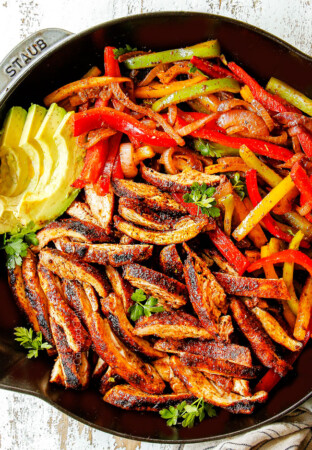




















Rose says
Jen, I’d love to make this but don’t eat meat! I don’t mind using beef or chicken broth, I just hate the texture of meat! Can I use fish, tofu, or tempeh in this recipe?
Jen says
Absolutely! If you eat shrimp then that would be delicious or you could also use tofu. Enjoy!
Jenny says
I made this tonight. I literally took a picture of my messy, cooked in kitchen to prove that I didn’t get it from a restaurant!! So so good!!
Jen says
LOL! That is awesome Jenny! I’m thrilled you loved it so much! Thanks for making my day!
Min-seo says
I made these Korean Noodles tonight and they were excellent. I look forward to making many more of your recipes. Thank you for sharing your recipe.
Jen says
You are so welcome Min-seo, I am so pleased you enjoyed them! I hope you enjoy exploring my site!
Natalie says
I don’t know how you do it Jen! Every recipe I’ve tried of yours has been outstanding including this one! This might be my new favorite although it’s so hard to pick!
Jen says
Ah, thank you so so much Natalie! I am honored you are loving my recipes so much and that this was another favorite – you have great taste 🙂
Cathy Lamb says
This was an effort to get all the ingredients. I live in Little Rock Ar. and I went to 5 stores trying to find Flank steak. Finally the butcher told me there are none in LR. The only place to buy them are in Memphis. Crazy! so he suggested Shank. It had been tenderized but it was still tough. I wondered if I could use round steak. It was so crazy good that I will make it again but just don’t know what meat to substitute.
Jen says
Hi Cathy, you can substitute ribeye or tri tip as well. I hope that helps!
Dianna says
I was going to try this with top sirloin steak. Can’t you also velvet the beef to make it more tender if using a tougher steak?
Jen says
Absolutely!
Denise says
I’m going to make the Korean Noodles as soon as my noodles arrive from Amazon. I’m a “mature” woman who is confident in the kitchen. That being said, I was thoroughly impressed and grateful for the excellent and detailed instructions! The helpful hints on where to purchase ingredients was an added plus. Your instructions were presented in an organized manner and are easy to follow. I look forward to trying more of your recipes. Thank you!
Jen says
Thank you so much for your thoughtful comment Denise! I’m honored you found my site and instructions helpful and I hope you found my Spicy Korean Noodles delicious!
Gail says
Any suggestions on making this gluten free would be greatly appreciated. Not sure what I can swap out the Annie Chuns sauce with. Love your website and recipes.Thank you for all you do!!
Jen says
Hi Gail, I believe these gochuchang sauces are gluten free: https://www.werubyou.com/ and http://www.gochujangsauce.com/ I hope that helps!
Mandy Dow says
I made this and it was awesome! I used tri-tip because that’s what I could find, and I used fettuccine because my kids are picky
Jen says
I’m so happy these Korean Spicy Noodles were a winner! Thanks for taking the time to comment Mandy!
Bill says
I have a question about the sesame oil; is it the brown toasted one or the colorless plain one?
Jen says
Hi Bill, use toasted if have it, otherwise regular is fine. Enjoy!
Carmela says
This was the first recipe of yours that I have tried and it was amazing! Love all of the helpful hints (froze my flank steak) and managed to buy the right mirin! I made another one of your recipes tonight and it was just as amazing,. I have been in a cooking rut so thank you!
Jen says
Welcome to my site Carmela! I’m so pleased you loved these Korean Spicy Noodles and that you found my tips helpful! I hope you enjoy exploring my site and that my recipes get you excited about cooking!
Nick says
Is their a particular rice wine you would recommend? I’ve read about Aji-Marin sweet rice wine and Kikkomon?
Thank you
Jen says
Hi Nick, I use “Kikkoman Manjo Aji-Mirin Sweet Cooking Rice Wine” in all me recipes. Enjoy!
Peter johnson says
Amazingly recipe as always with your recipes. I made it vegan by adding vegan beef strips and used roasted cashew nuts with pak choi. The flavours are second to none. Many thanks
Jen says
You are so welcome Peter, thanks for taking the time to comment! I’m so pleased you could make it vegan!